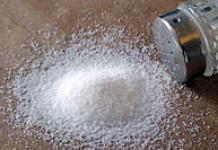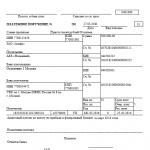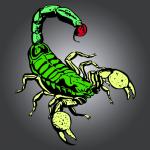Table salt of natural origin almost always contains admixtures of other mineral salts, which can give it shades of different colors (usually gray).
According to the method of extraction, salt is divided into several types:
- stone. Rock salt lies in the ground in layers and is mined using a mountain method;
- self-planting, or lake. This salt is found in the form of layers at the bottom of lakes and is the main source of salt in the CIS;
- garden salt. Garden salt is obtained by evaporation or freezing from the water of estuaries and lakes;
- evaporation. Evaporated salt is obtained by evaporation from underground brines.
Edible salt is produced:
in terms of quality - extra, highest, first and second grades;
according to the granulometric composition - grindings No. 1, 2 and 3.
 Food salt is used in boiler houses for the chemical purification of heating water, in food production for the preservation and preservation of all types of animal products (meat, fish, etc.), fruits and vegetables, animal feed, etc., in the production of detergents and for other purposes.
Food salt is used in boiler houses for the chemical purification of heating water, in food production for the preservation and preservation of all types of animal products (meat, fish, etc.), fruits and vegetables, animal feed, etc., in the production of detergents and for other purposes.
It also serves as a raw material for the production of chlorine, hydrochloric acid, caustic soda, soda, the production of sodium metal, and is used in dyeing, soap making and many other industries.
Significant volumes of rock salt (up to 30-35%) are used to combat icing of highways and other roads. On average, more than half of the salt produced is used in the food industry, about 40% is used for technical purposes, and the remainder is so-called feed salt.
| Indicator name | Standard for variety | ||
| Extra | Higher | First | |
| Appearance | Crystalline bulk product | ||
| Taste | Salty without any foreign taste | ||
| Color | White | ||
| Smell | Absent | ||
| physical and chemical indicators | |||
| Mass fraction of sodium chloride, %, not less | 99,50 * | 98,20 * | 97,50 * |
| Mass fraction of calcium ion, %, no more | 0,02 * | 0,35 * | 0,55 * |
| Mass fraction of magnesium ion, %, no more | 0,01 * | 0,08 * | 0,10 * |
| Mass fraction of sulfate ion, %, no more | 0,20 * | 0,85 * | 1,20 * |
| Mass fraction of potassium ion, %, no more | 0,02 * | 0,10 * | 0,20 * |
| Mass fraction of iron (III) oxide, %, no more | 0,005 * | 0,040 * | 0,040 * |
| Mass fraction of sodium sulfate, %, no more | 0,21 * | Not regulated | |
| Mass fraction of water-insoluble residue (n.o.), %, no more | 0,03 * | 0,25 * | 0,45 * |
| Mass fraction of moisture, %, no more | 0,10 | 0,70 | 0,70 |
| Solution pH | 6,5-8,0 | Not regulated | |
| Size: up to 0.5 mm inclusive, %, not less over 0.5 mm to 1.2 mm, %, no more |
95,0 * 5,0 * |
95,0 * 5,0 * |
95,0 * 5,0 * |
Note.
* - in terms of dry matter.
The mass fraction of potassium ferrocyanide for salt with an anti-caking additive is not more than 0.001%.
The content of toxic elements and radionuclides is within the limits of existing sanitary standards.
Safety requirements for table salt GOST 13830-97.
Food salt (sodium chloride, sodium chloride) is fire- and explosion-proof, non-toxic. If it comes into contact with intact skin, it has no harmful effect, however, if it gets on skin wounds, it impairs their healing.
Packaging, transportation and storage.
Edible salt is produced in packaged form. Depending on the net weight, salt is packaged in polyethylene or propylene bags (up to 50 kg), soft specialized disposable containers (900-1000 kg).
Packaged food salt is transported by all types of transport in accordance with the cargo transportation rules in force for this type of transport. Vehicles must be covered, clean and dry.
Transportation of food salt during container shipments is carried out in covered wagons, gondola cars, on specialized railway platforms, ships, as well as by road.
Edible salt is stored in dry warehouses. It is allowed to store the product in containers on hard-surfaced areas equipped with canopies.
The guaranteed shelf life of salt without additives, packed in packs with an inner bag and in cardboard packs is two and a half years, in packs without an inner bag - one year, in plastic bags - two years, in paper bags with a polyethylene liner, polyethylene and polypropylene woven - two years, in containers of all types with a polyethylene liner - two years, in containers without a liner - one year.
The shelf life under controlled temperature and humidity conditions of salt without additives, packed in plastic bags, polypropylene bags with polyethylene liners, soft containers with plastic liners is five years.
It is useful to know the chemical formulas of substances common in everyday life not only as part of a school chemistry course, but also simply for general erudition. Almost everyone knows the formula for water or table salt, but few can immediately get to the point about alcohol, sugar or vinegar. Let's go from simple to complex.

What is the formula of water?
Everyone knows and drinks this liquid, thanks to which amazing wildlife appeared on planet Earth. Moreover, it makes up about 70% of our body. Water is the simplest compound of an oxygen atom with two hydrogen atoms.
Chemical formula of water: H 2 O
What is the formula for table salt?
Table salt is not only an indispensable culinary dish, but also one of the main components of sea salt, the reserves of which in the World Ocean amount to millions of tons. The formula for table salt is simple and easy to remember: 1 sodium atom and 1 chlorine atom.
Chemical formula of table salt: NaCl
What is the formula for sugar?
Sugar is a white crystalline powder, without which not a single sweet tooth in the world can live a day. Sugar is a complex organic compound whose formula is hard to remember: 12 carbon atoms, 22 hydrogen atoms and 11 oxygen atoms form a sweet and complex structure.
Chemical formula of sugar: C 12 H 22 O 11
What is the formula of vinegar?
Vinegar is a solution of acetic acid that is used for food and also for cleaning metals from plaque. The acetic acid molecule has a complex structure, consisting of two carbon atoms, to one of which three hydrogen atoms are attached, and to the other two oxygen atoms, one of which has grabbed another hydrogen.
Chemical formula of acetic acid: CH 3 COOH
What is the formula of alcohol?
Let's start with the fact that there are different types of alcohols. The alcohol that is used to make wine, vodka and cognac is scientifically called ethanol. In addition to ethanol, there are also a bunch of alcohols that are used in medicine, automotive and aviation.
Chemical formula of ethanol: C 2 H 5 OH
What is the formula for baking soda?
Baking soda is scientifically called sodium bicarbonate. From this name, any novice chemist will understand that the soda molecule contains sodium, carbon, oxygen and hydrogen.
Chemical formula of baking soda: NaHCO 3
Today is July 6, 2019. Do you know what holiday is today?
Tell me What is the formula for sugar, salt, water, alcohol, vinegar and other substances friends on social networks:
Hypertonic salt solution - medicinal properties
(see below for what the salt formula looks like)
Table salt is a food product; which has other names: table salt or rock, table salt...
The largest salt deposit in the world is the Dead Sea.
Table salt
Production of table salt as early as 5 thousand years ago BC. e. was established on the territory of present-day Bulgaria. In Rus', our ancestors learned to obtain salt in the twelfth century.

In fact, natural salt also contains other salts (mineral), due to which the salt itself has a mostly brown or gray tint. Small or large white crystals of salt are the result of grinding it.
Representatives (workers) of the salt industry are engaged in the extraction and processing of table salt. In the chemical industry, salt is used to produce chlorine and soda. 
China and the USA are the largest salt producers on the planet.
The presence of salt in the body of living beings, including humans, is a prerequisite for their existence.
Formula Table salt

salt formula (sodium chloride) – NaCl
( Na ) – The fact is that sodium (or more precisely, its ions) takes part in the transmission of impulses (nerve) and contraction of muscles (their fibers); and the disadvantage of this is: chronic fatigue and an increased level of fatigue in the body.
( Cl ) – Chlorine (chlorine ions) is the basis for the formation of hydrochloric acid, which is part of the gastric juice and is directly involved in the digestion of food.

Beneficial properties of salt
- preservative: onions placed in a plate, the bottom of which is sprinkled with salt, are stored longer;
- to wash the knife from the smell of the same onion, you should wipe it with a rag with salt;
- in principle, with the help of salt you can easily wash your hands from the unpleasant smell of garlic, onions, fish;
- when cleaning fish, it is better to grease it with salt - this way it will not slip out of your hands);
- To ensure that sharpening a knife does not cause difficulties, initially place the blade in a saline solution (with a slight concentration of salt);
- if your milk runs out, then pour salt on the dirty area of the stove - the burning smell will disappear;
- If you add salt to fat, it will stop foaming...
Basically, if you clearly taste salt in your food, this indicates that you already have enough of it in your body; and vice versa…
Salt treatment
How to prepare a hypertonic solution
The healing properties of salt have been known since World War II, when dressings with hypertonic salt solution were used to treat wounds.

A hypertonic solution is an active sorbent that draws pathogenic microflora from a diseased organ.
Dressings soaked in saline solution clean wounds and have an antimicrobial effect.
The fabric for the saline dressing should be breathable cotton fabric.
The amount of salt in the solution should be no more than 8-9% (80-90 g per 1 liter of boiled water). The bandage is applied to the diseased area and over time the pathogenic fluid is drawn out. The body is cleansed of pathogenic material. Do not use film on top.
In folk medicine, salt is used to treat:
- dental caries and periodontal disease,
- chronic appendicitis,
- hematomas,
- inflammation of the lung tissue,
- rheumatic carditis,
- articular rheumatism, etc.
Other uses for table salt solution:
- rinsing the nasopharynx with a salt solution during inflammatory processes,
- relief from heel pain due to spurs and pressure.
Salt intake rate
You should not allow more than ten grams of salt into the body per day (under normal conditions), and more than twenty grams in hot weather. Please note: we are talking about the total amount of salt in food, and not in its pure form; After all, salt is found in many foods.
Our body “compensates” for the lack of salt by destroying muscle and bone tissue. 
What does a lack of salt in the body lead to?
To arise:
- nervous disorders
- mental illness, spasms,
- disorders of the heart and gastrointestinal tract.
What does a constant excess of salt in the body lead to:
- high blood pressure,
- stomach cancer,
- diseases of the eyes, heart and kidneys,
- heart attack, stroke.
Facts about salt - no salt and too much salt

If a person consumes an amount of salt per day equal to 3 grams per 1 kilogram of body weight, death will be inevitable.
And if you do not consume salt at all, in any form, for more than ten days, the person will also die. On average, we eat 5 kilograms of salt per year.
If you adhere to the norm, everything will be normal in the body and with health everything will be fine.
 inf
inf
Other category materials:

Herbs that help with menstrual pain - herbal recipes

How to get rid of fungus, calluses and corns on your feet with aspirin

The foundations for dividing salts into separate groups were laid in the works of a French chemist and pharmacist G. Ruel(\(1703\)–\(1770\)) . It was he who in \(1754\) proposed dividing the salts known by that time into acidic, basic and medium (neutral). Currently, other groups of this extremely important class of compounds are being identified.
Medium salts
Medium salts are salts that contain a metal chemical element and an acidic residue.
Instead of a metal chemical element, ammonium salts contain a monovalent ammonium group NH 4 I.
Examples of medium salts:
Na I Cl I - sodium chloride;
Al 2 III SO 4 II 3 - aluminum sulfate;
NH I 4 NO 3 I - ammonium nitrate.
Acid salts
Salts are called acidic if they contain, in addition to a metal chemical element and an acidic residue, hydrogen atoms.
Pay attention!
When composing the formulas of acid salts, it should be borne in mind that the valence of the acid residue is numerically equal to the number of hydrogen atoms that were part of the acid molecule and replaced by the metal.
When compiling the name of such a compound, the prefix “” is added to the name of the salt. hydro", if the acid residue contains one hydrogen atom, and " dihydro"if the acid residue contains two hydrogen atoms.
Examples of acid salts:
Ca II HCO 3 I 2 - calcium bicarbonate;
Na 2 I HPO 4 II - sodium hydrogen phosphate;
Na I H 2 PO 4 I is sodium dihydrogen phosphate.
The simplest example of acidic salts is baking soda, i.e. sodium bicarbonate \(NaHCO_3\).
Basic salts
Basic salts are salts that contain, in addition to a metal chemical element and an acidic residue, hydroxyl groups.
Basic salts can be considered as a product of incomplete neutralization of a polyacid base.
Pay attention!
When composing the formulas of such substances, it should be borne in mind that the valency of the residue from the base is numerically equal to the number of hydroxo groups that have “left” the composition of the base.
When compiling the name of the main salt, the prefix “ hydroxo", if the remainder of the base contains one hydroxo group, and " dihydroxo", if the remainder of the base contains two hydroxo groups.
Examples of basic salts:
MgOH I Cl I - magnesium hydroxychloride;
Fe OH II NO 3 2 I - iron hydroxonitrate (\(III\));
Fe OH 2 I NO 3 I - iron dihydroxonitrate (\(III\)).
A well-known example of basic salts is the green deposit of copper hydroxycarbonate (\(II\)) \((CuOH)_2CO_3\), which forms over time on copper objects and objects made from copper alloys if they are in contact with moist air. The mineral malachite has the same composition.
Complex salts
Complex compounds are a diverse class of substances. The merit in creating a theory that explains their composition and structure belongs to the Nobel Prize laureate in chemistry \(1913\) Swiss scientist A. Werner (\(1866\)–\(1919\)). True, the term “complex compounds” was introduced in \(1889\) by another outstanding chemist, Nobel Prize laureate \(1909\). V. Ostwald (\(1853\)–\(1932\)).
The cation or anion of complex salts contains complexing element associated with so-called ligands. The number of ligands that the complexing agent attaches is called coordination number. For example, the coordination number of divalent copper, as well as beryllium and zinc, is \(4\). The coordination number of aluminum, iron, trivalent chromium is \(6\).
In the name of a complex compound, the number of ligands connected to the complexing agent is represented by Greek numerals: \(2\) - “ di", \(3\) - " three", \(4\) - " tetra", \(5\) - " penta", \(6\) - " hexa" Both electrically neutral molecules and ions can act as ligands.
The name of the complex anion begins with the composition of the inner sphere.
If anions act as ligands, the ending “ -O»:
\(–Cl\) - chloro-, \(–OH\) - hydroxo-, \(–CN\) - cyano-.
If the ligands are electrically neutral water molecules, the name " aqua", and if ammonia - the name " ammin».
Then the complexing agent is called using its Latin name and the ending “- at", after which, without a space, the degree of oxidation is indicated in Roman numerals in brackets (if the complexing agent can have several oxidation states).
After indicating the composition of the inner sphere, indicate the name of the cation of the outer sphere - the one that is outside the square brackets in the chemical formula of the substance.
Example:
K 2 Zn OH 4 - potassium tetrahydroxozincate,
K 3 Al OH 6 - potassium hexahydroxoaluminate,
K 4 Fe CN 6 - potassium hexacyanoferrate (\(II\)).
In school textbooks, the formulas for complex salts of more complex composition are, as a rule, simplified. For example, the formula of potassium tetrahydroxodiaquaaluminate K Al H 2 O 2 OH 4 is usually written as the formula of tetrahydroxoaluminate.
If the complexing agent is part of the cation, then the name of the inner sphere is composed in the same way as in the case of a complex anion, but the Russian name of the complexing agent is used and the degree of its oxidation is indicated in parentheses.
Example:
Ag NH 3 2 Cl - diammine silver chloride,
Cu H 2 O 4 SO 4 - tetraaquacopper sulfate (\(II\)).
Crystal hydrates of salts
Hydrates are the products of the addition of water to particles of a substance (the term is derived from the Greek hydor- “water”).
Many salts precipitate from solutions in the form crystalline hydrates- crystals containing water molecules. In crystalline hydrates, water molecules are tightly bound to cations or anions that form a crystal lattice. Many salts of this type are essentially complex compounds. Although many of the crystal hydrates have been known since time immemorial, the systematic study of their composition was started by the Dutch chemist B. Rosebohm (\(1857\)–\(1907\)).
In the chemical formulas of crystalline hydrates, it is customary to indicate the ratio of the amount of salt substance and the amount of water substance.
Pay attention!
The dot that divides the chemical formula of crystalline hydrate into two parts, unlike mathematical expressions, does not indicate the action of multiplication and is read as the preposition “with”.
.The formula of which is NaCl is a food product. In inorganic chemistry, this substance is called sodium chloride. In its crushed form, table salt, the formula of which is given above, appears as white crystals. Insignificant gray shades may appear in the presence of other mineral salts as impurities.
It is produced in various forms: unrefined and purified, small and large, iodized.
Biological significance
A crystal of table salt, which has an ionic chemical bond, is necessary for the full life and activity of humans and other living organisms. Sodium chloride takes part in regulating and maintaining water-salt balance and alkaline metabolism. Biological mechanisms control the constant concentration of sodium chloride in various fluids, such as blood.
The difference in NaCl concentrations inside and outside the cell is the main mechanism for the entry of nutrients into the cell, as well as the removal of waste products. A similar process is used in the generation and transmission of impulses by neurons. Also, the chlorine anion in this compound is the main material for the formation of hydrochloric acid, the most important component of gastric juice.
The daily requirement for this substance is from 1.5 to 4 grams, and for hot climates the dose of sodium chloride increases several times.
The body does not need the compound itself, but the Na+ cation and the Cl- anion. If the amount of these ions is insufficient, muscle and bone tissue is destroyed. Depression, mental and nervous diseases, disturbances in the cardiovascular system and digestive processes, muscle spasms, anorexia, and osteoporosis appear.
Chronic lack of Na+ and Cl- ions leads to death. Biochemist Zhores Medvedev noted that with the complete absence of salt in the body, one can last no more than 11 days.
Even in ancient times, tribes of cattle breeders and hunters consumed raw meat products to satisfy the body's need for salt. Agricultural tribes consumed plant foods that contained small amounts of sodium chloride. Signs indicating a lack of salt include weakness and headache, nausea, and dizziness.

Production Features
In the distant past, salt was extracted by burning certain plants in fires. The resulting ash was used as a seasoning.
Table salt obtained by evaporating sea water was not purified; the resulting substance was immediately consumed as food. This technology originated in countries with hot and dry climates, where a similar process occurred without human intervention, and then, when other countries adopted it, sea water began to be heated artificially.
Saltworks were built on the shores of the White Sea, in which concentrated brine and fresh water were obtained by evaporation and freezing.

Natural deposits
Among the places characterized by large reserves of table salt, we highlight:
- Artemovskoye field, located in the Donetsk region. Salt is extracted here using the mine method;
- Lake Baskunchak, transportation is carried out along a specially built railway;
- potassium salts were found in large quantities in the Verkhnekamskoye deposit, where this mineral is mined using the mine method;
- mining was carried out in the Odessa estuaries until 1931; currently the deposit is not used on an industrial scale;
- In the Seregovskoye deposit, brine is evaporated.
Salt mine
The biological properties of table salt made it an important economic object. As of 2006, about 4.5 million tons of this mineral were used on the Russian market, with 0.56 million tons going for food consumption, and the remaining 4 million tons going to the needs of the chemical industry.

physical characteristics
Let's look at some properties of table salt. This substance dissolves quite well in water, and the process is influenced by several factors:
- temperature;
- presence of impurities.
A crystal of table salt contains impurities in the form of calcium and magnesium cations. This is why sodium chloride absorbs water (it becomes damp in the air). If such ions are not part of table salt, this property is absent.
The melting point of table salt is 800.8 °C, which indicates the strong crystalline structure of this compound. Mixing fine sodium chloride powder with crushed ice produces a high quality coolant.
For example, 100 g of ice and 30 g of table salt can reduce the temperature to −20 °C. The reason for this phenomenon is that the table salt solution freezes at temperatures below 0 °C. Ice, for which this value is the melting point, melts in such a solution, absorbing heat from the environment.
The high melting point of table salt explains its thermodynamic characteristics, as well as its high dielectric constant - 6.3.

Receipt
Considering how important the biological and chemical properties of table salt and its significant natural reserves are, there is no need to develop an option for the industrial production of this substance. Let's look at laboratory options for producing sodium chloride:
- This compound can be obtained as a product by reacting copper (2) sulfate with barium chloride. After removing the precipitate, which is barium sulfate, and evaporating the filtrate, crystals of table salt can be obtained.
- When sodium exothermicly combines with chlorine gas, sodium chloride is also formed, and the process is accompanied by the release of a significant amount of heat (exothermic form).
Interactions
What are the chemical properties of table salt? This compound is formed by a strong base and a strong acid, so hydrolysis does not occur in an aqueous solution. The neutrality of the environment explains the use of table salt in the food industry.
During the electrolysis of an aqueous solution of this compound, hydrogen gas is released at the cathode, and the formation of chlorine occurs at the anode. Sodium hydroxide accumulates in the interelectrode space.
Considering that the resulting alkali is a substance in demand in various production processes, this also explains the use of table salt on an industrial scale in chemical production.
The density of table salt is 2.17 g/cm3. A cubic face-centered crystal lattice is characteristic of many minerals. Inside it, ionic chemical bonds predominate, formed due to the action of forces of electrostatic attraction and repulsion.

Halite
Since the density of table salt in this compound is quite high (2.1-2.2 g/cm³), halite is a solid mineral. The percentage of sodium cation in it is 39.34%, chlorine anion - 60.66%. In addition to these ions, halite contains ions of bromine, copper, silver, calcium, oxygen, lead, potassium, manganese, nitrogen, and hydrogen in the form of impurities. This transparent, colorless mineral with a glassy luster is formed in closed bodies of water. Halite is a product of distillation in volcanic craters.
Rock salt
It is a sedimentary rock from the evaporite group that consists of more than 90 percent halite. Rock salt is characterized by a snow-white color; only in exceptional cases, the presence of clay gives the mineral a gray tint, and the presence of iron oxides gives the compound a yellow or orange color. Rock salt contains not only sodium chloride, but also many other chemical compounds of magnesium, calcium, and potassium:
- iodides;
- borates;
- bromides;
- sulfates.
Depending on the formation conditions, the main rock salt deposits are divided into several types:
- underground salt waters;
- brines of modern swimming pools;
- deposits of mineral salts;
- fossil deposits.
Sea salt
It is a mixture of sulfates, carbonates, potassium and sodium chlorides. During its evaporation at temperatures ranging from +20 to +35 °C, the crystallization of less soluble salts initially occurs: magnesium and calcium carbonates, as well as calcium sulfate. Next, soluble chlorides, as well as magnesium and sodium sulfates, precipitate. The crystallization sequence of these inorganic salts can change taking into account the temperature, the rate of the evaporation process, and other conditions.
In industrial quantities, sea salt is obtained from sea water by evaporation. It differs significantly in microbiological and chemical parameters from rock salt; it has a high percentage of iodine, magnesium, potassium, and manganese. Due to the different chemical composition, there are differences in organoleptic characteristics. Sea salt is used in medicine as a remedy for the treatment of skin diseases, such as psoriasis. Among the common products offered in the pharmacy chain, we highlight Dead Sea salt. Purified sea salt is also offered in the food industry as iodized salt.
Regular table salt has weak antiseptic properties. With a percentage of this substance in the range of 10-15 percent, the appearance of putrefactive bacteria can be prevented. It is for these purposes that sodium chloride is added as a preservative to food, as well as other organic masses: wood, glue, leather.

Abuse of salt
According to the World Health Organization, excessive consumption of sodium chloride leads to a significant increase in blood pressure, as a result of which kidney and heart diseases, stomach diseases, and osteoporosis often develop.
Together with other sodium salts, sodium chloride is the cause of eye diseases. Table salt retains fluid inside the body, which leads to increased intraocular pressure and the formation of cataracts.
Instead of a conclusion
Sodium chloride, commonly referred to as table salt, is a widely occurring inorganic mineral in nature. This fact greatly simplifies its use in the food and chemical industries. There is no need to spend time and energy resources on the industrial production of this substance, which affects its cost. In order to prevent an excess of this compound in the body, it is necessary to control the daily consumption of salty foods.




















